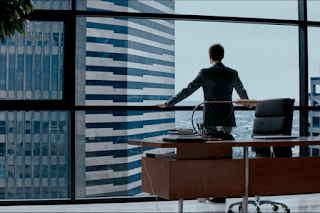Power of visuals
We live in a world ruled almost entirely by media, constantly bombarded with news and ads. How many of us find the time to read one complete article? The deciding factor is often the headline. We read if we find the title catchy.
But what about pictures? We ignore some after a glance. We look at some to see what it conveys. But then, there are pictures we look at the second time. Something about them that's so captivating.
Is it true that a picture's interpretation lies in the eyes of the beholder?
Why are certain pictures so subjective that they draw our attention and demand an interpretation? How many of us can even be unbiased in judging a picture?
The above picture might make no difference to a lot of people. But to those 61 survivors, this picture would be a lump in the throat with haunting memories. And, to this who lost their loved one's, this picture would ignite a thought imagining what if the planes had remained this far cut short by the next image.
Every picture brings a certain amount of baggage to some.
A visual piece lets the viewer think without boundaries. Within the definition of a visual, one can let their minds move freely. One's interpretation is not influenced. To one, it's their own.
But is that all? Are visuals just that simple? To see? To make?
What about professional media workers? Is it just about being inquisitive and passionate? Does that make it easy for them to look at pictures and judge them?
Are all the pictures meant only for people who can see? What about people who might not be "gifted" with an eyesight but can still feel pictures with the rest of their senses put to good use.
I came across a book Essentials of visual communication by Bo Bergstrom that brilliantly explains this.
We all share a sense of exclusion in the world of pictures.
But why are we scared of seeing pictures?
"Opening our eyes to what fascinates us, but also to what frightens us."
I find these words powerful.
Most people are afraid of pictures — they slide away from us. They reveal and expose those who get close to them.
Analysing a picture can often have more to say about the observer. The entire process of analysis becomes a self-portrait.
In the book, he cites an example. Most people would find a photograph that depicts an eye being cut into pieces unbearable to look at. But, it might be all in a day's work for a butcher. Imagine how easy it would be for a prospective axe murderer?
That's the baggage.
Pictures teach us the value of admitting our secrets, and also, the dangers of hiding them.
It is not any different for media workers either for whom pictures, colour and shape are the very breath of life. Maybe yes. Not to those who have mastered the visual elements.
For those who have several rungs on the ladder left, knowledge is the only cure.
When you hear a photographer voice his fear of pictures once he's turned off the lights, it rings a bell. Irrespective of the passion that we behold for visuals, colours, forms and textures, to fill the gap between talking and understanding the inner meaning, it requires pure knowledge through experimentation.
Talking about backgrounds and props is not the same as understanding the essence of every element used.
To be able to actually hold them, feel them and see how every fraction of a change makes a huge difference is what helps us battle that fear. We understand why one visual would work while the other would fail. To have a judgement based on a strong reason counts on our experimental expertise. And that gives us the confidence to put our visual through interpretation and criticism as well.
And finding inspiration in such people who understand the importance of creating point of contacts through images, messages, form and colour for a narrative, is inspiring in itself.
And the only way to be able to deal with this is by letting go and expressing effectively through the language of visuals.
It's necessary to understand both linguistic and figurative means of expression from a very young age. Blind and sighted alike, must be taught to understand colour and shape and not be limited to language.
But what about pictures? We ignore some after a glance. We look at some to see what it conveys. But then, there are pictures we look at the second time. Something about them that's so captivating.
Is it true that a picture's interpretation lies in the eyes of the beholder?
Why are certain pictures so subjective that they draw our attention and demand an interpretation? How many of us can even be unbiased in judging a picture?
 |
| The Pan Am and KLM planes just before the Tenerife Disaster (1977) |
The above picture might make no difference to a lot of people. But to those 61 survivors, this picture would be a lump in the throat with haunting memories. And, to this who lost their loved one's, this picture would ignite a thought imagining what if the planes had remained this far cut short by the next image.
 |
| The KLM airplane had peeled off the top of the Pan Am plane. Everyone in the section had gone. |
Every picture brings a certain amount of baggage to some.
A visual piece lets the viewer think without boundaries. Within the definition of a visual, one can let their minds move freely. One's interpretation is not influenced. To one, it's their own.
But is that all? Are visuals just that simple? To see? To make?
Are all the pictures meant only for people who can see? What about people who might not be "gifted" with an eyesight but can still feel pictures with the rest of their senses put to good use.
I came across a book Essentials of visual communication by Bo Bergstrom that brilliantly explains this.
We all share a sense of exclusion in the world of pictures.
But why are we scared of seeing pictures?
"Opening our eyes to what fascinates us, but also to what frightens us."
I find these words powerful.
Most people are afraid of pictures — they slide away from us. They reveal and expose those who get close to them.
Analysing a picture can often have more to say about the observer. The entire process of analysis becomes a self-portrait.
In the book, he cites an example. Most people would find a photograph that depicts an eye being cut into pieces unbearable to look at. But, it might be all in a day's work for a butcher. Imagine how easy it would be for a prospective axe murderer?
That's the baggage.
Pictures teach us the value of admitting our secrets, and also, the dangers of hiding them.
It is not any different for media workers either for whom pictures, colour and shape are the very breath of life. Maybe yes. Not to those who have mastered the visual elements.
For those who have several rungs on the ladder left, knowledge is the only cure.
When you hear a photographer voice his fear of pictures once he's turned off the lights, it rings a bell. Irrespective of the passion that we behold for visuals, colours, forms and textures, to fill the gap between talking and understanding the inner meaning, it requires pure knowledge through experimentation.
Talking about backgrounds and props is not the same as understanding the essence of every element used.
To be able to actually hold them, feel them and see how every fraction of a change makes a huge difference is what helps us battle that fear. We understand why one visual would work while the other would fail. To have a judgement based on a strong reason counts on our experimental expertise. And that gives us the confidence to put our visual through interpretation and criticism as well.
And finding inspiration in such people who understand the importance of creating point of contacts through images, messages, form and colour for a narrative, is inspiring in itself.
And the only way to be able to deal with this is by letting go and expressing effectively through the language of visuals.
It's necessary to understand both linguistic and figurative means of expression from a very young age. Blind and sighted alike, must be taught to understand colour and shape and not be limited to language.

Comments
Post a Comment